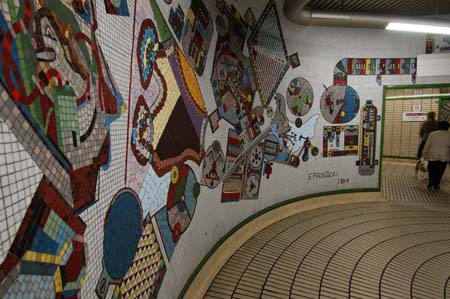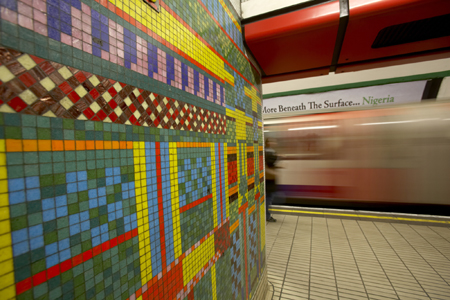2009 Update on the Tottenham Court Road Tube Paolozzi
Mosaics
by Paul Bentley

A lot of building work is happening at this station just now, so
we asked the authorities if the work would include keeping, cleaning and
restoring the great Paolozzi mosaics there. They replied: "London
Underground recognises the importance of the Paolozzi mosaics within Tottenham
Court Road Underground station, and our architects, alongside the Tube’s
Art on the Underground programme, are working closely with the Paolozzi
Foundation as we develop the station design to help preserve them.
"Wherever possible, the mosaics will be maintained throughout the
station. Where it is essential that upgrade work is carried out, for example,
on platform walls, any repairs to the mosaics will be carried out in consultation
with the Paolozzi Foundation. An artist will be commissioned in due course,
in consultation with the Foundation, to carry out these restoration works."
(Further information can be obtained from Tottenham Court Road Customer
Services
email: helpdesk@crossrail.co.uk or call 0345 602 3813)
So while we are waiting to see how things turn out, here's an article
originally written for Grout, BAMM's
magazine, in 2002.
PAOLOZZI AT TOTTENHAM COURT ROAD
Eduardo Luigi Paolozzi is of course a Scot. He was born in 1924 in Leith,
near Edinburgh, the only son of Italian peasants who owned an ice-cream
shop in the town. You might think ice-cream would be one thing which had
no influence on his art but you would be wrong – in the shop there
was a wonderful freezer with two stainless steel blades…. His love
affair with machinery had begun, though as a child he also drew pictures
of film stars and street scenes. Armed with these drawings he got into
the Edinburgh College of Art, aged nineteen. Then he went to St. Martin's
School of Art in London and the Slade and in 1947, armed with £75
from his graduation show, moved to Paris.
There he met Giacometti, Tzara, Brancusi, Braque and Léger and
was influenced by Surrealism, unsurprisingly. Two years later he was back,
teaching textile design at the Central School. He has done a lot of teaching
– for example he was Professor of Ceramics in Cologne and at the
Royal College of Art (the latter for almost thirty years), and in Munich
he was Professor of Sculpture. In 1986 he was made Her Majesty's Sculptor
in Ordinary for Scotland; the knighthood came in 1989. He is member of
the Royal Academy, and was asked to sculpt Isaac Newton for the British
Library.
The range of his work is vast and includes collages, abstract sculpture,
ceramics, textiles, silk screen printing, stained glass and paintings.
Much of his work displays his passionate interest in science and technology.
The Tottenham Court Road underground mosaics were commissioned by London
Regional Transport in 1979, because a member of the tube decoration team
saw a photo of a 1976 Paolozzi painted mural in Berlin. That mural was
big - 990 square metres. For the tube murals (995 sq.mts.) ceramic tile
was chosen to begin with, later changed to mosaic because of its greater
flexibility in creating intricate forms, and because it is more striking
at close quarters. Ceramicists might disagree. The materials used were
vitreous, smalti and piastrelle, irregularly shaped blocks made of the
same material as smalti. The method was reverse, because the mosaics had
to be as smooth as possible, given that passengers, sorry, customers would
be brushing past them.

When working on the designs Paolozzi considered the public as one of the
clients. What happens when the platforms are crowded? In the rush hour?
How would people react to metaphors and images which relate to the life
above ground, in the district around the station? Cameras, music shops,
saxophones, electronics, the British Museum, Architectural Association
students, even memories "of an all-night Turkish bath formerly in
the Russell Hotel"? The official catalogue (see below) claims that
this Turkish bath memory became mosaic butterflies scattered through the
tunnels, though it seems more likely that these insects are in fact moths.
Paolozzi did masses of preliminary designs – he has never lacked
energy – collage drawings, watercolours and experimental Xerox copies
of these in various colours. The Tottenham Court Road designs are a summation
of Paolozzi's lifelong interests. Forms which at first seem abstract become
more specific on inspection – television images, computer games,
car wheels, machinery. The exotic mixture of ingredients reflects Paolozzi's
pleasure in the multi-cultural world of London. It's interesting to note
that he felt that mosaics bordering a doorway or passage (where people
pass swiftly through) should never be as complex or flamboyant as those
filling a platform wall (where people stand still for minutes at a time).
The Central Line is red, so red was central to the design, with different
colour ranges in the east-bound and west-bound tunnels. Black of course
dominated the Northern Line designs: these had more subdued colour, harder
and more geometrical variations on the basic vocabulary – it's a
tough opus regulatum world. The Rotunda was more representational: a running
commuter man, a fast-food chicken and hamburger, cogs, pistons, cow, voodoo
masks. The last stage of the design was the Oxford Street entrance, which
is an amalgam of all Paolozzi's imagery and techniques and acts as an
overture to what lies below.
He used a model maker, Ray Watson, at the design stage, and three firms
actually made the mosaics - Italmosaic of Spilimbergo (Central Line),
Carter Contracting of London (Northern Line), and Art Pavements (Rotunda,
Oxford Street entrance, "watch-strap" escalator mosaics).
When you go to see the mosaics you may find that the tunnels and passageways
are so narrow you can't really get away sufficiently to see the mosaics
properly. The walls opposite the platforms, which would have been ideal,
were to have been mosaiced but London Transport decided it couldn't afford
to lose the advertising. So Paolozzi used bold design and colour to arrest
the attention at close quarters (as compared, say, to the lugubrious ceramics
at Waterloo Station), plus a wide variety of textures and patterns, ranging
from opus regulatum to opus palladianum (crazy paving).
At present the mosaics need cleaning and some restoration; BAMM is corresponding
with the relevant authorities. The murals are a triumphantly successful
celebration of London life and art and deserve to look at their best.
(Paul Bentley, 2002; largely based on Eduardo Paolozzi Underground,
edited by Richard Cork, Royal Academy of Arts catalogue, Weidenfeld and
Nicolson 1986. The BAMM Peter Fischer Library has a copy; it can be borrowed
by contacting Chris Blanchett of Buckland Books.)
Sir Eduardo Luigi Paolozzi, KBE, FRA died on 22 April 2005.
Note - Flash photography is not allowed on the London Underground
network.
|



